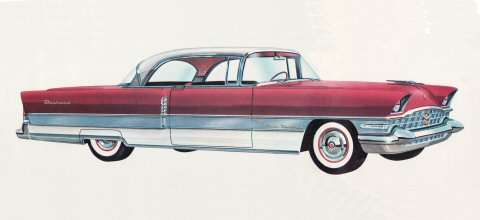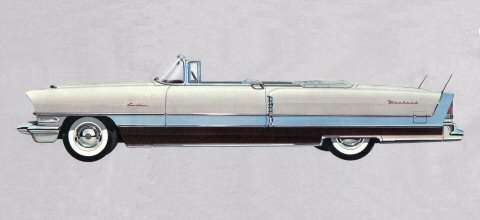|
Re: Which Packard engine was comparable to Buick's Dyna-Flash inline eight?
|
||||
|---|---|---|---|---|
|
Home away from home
|
I don't think there was a directly comparable model in 1938. In 1940 - 1942, I'd say a short wheelbase 160 (1803-1903-2003) with the 356 would be the competition in the heavyweight performance "gentleman's hot rod" class. 41-2 Centuries had the breathing advantage of dual carbs, but I believe still had babbit bearings.
Posted on: 2019/8/13 13:25
|
|||
|
||||
|
Re: Which Packard engine was comparable to Buick's Dyna-Flash inline eight?
|
||||
|---|---|---|---|---|
|
Home away from home

|
Buick man here too
Posted on: 2019/8/14 4:15
|
|||
|
||||
|
Re: Which Packard engine was comparable to Buick's Dyna-Flash inline eight?
|
||||
|---|---|---|---|---|
|
Home away from home
|
Quote:
PLUS, body style for body style, the Packard was lighter. I'd say the Packard would take the Buick.
Posted on: 2019/8/14 11:59
|
|||
|
West Peterson
1930 Packard Speedster Eight boattail (SOLD) 1940 Packard 1808 w/Factory Air (SOLD) 1947 Chrysler Town and Country sedan 1970 Camaro RS 1936 Cord phaeton packardinfo.com/xoops/html/modules/newbb/viewtopic.php?topic_id=4307&forum=10 aaca.org/ |
||||
|
||||
|
Re: Which Packard engine was comparable to Buick's Dyna-Flash inline eight?
|
||||
|---|---|---|---|---|
|
Home away from home
|
Was the 356 engine descended from any of the previous engines Packard was making? I had seen they made a 320 c.i.
John
Posted on: 2019/8/14 15:34
|
|||
|
||||
|
Re: Which Packard engine was comparable to Buick's Dyna-Flash inline eight?
|
||||
|---|---|---|---|---|
|
Forum Ambassador

|
The 356 engine was a completely new design for 1940.
The 320 dated back to 1929 and in terms of general design, back to its larger displacement sibling of 1924; like many engines of that era it had a two-piece crankcase, aluminum lower and cast iron upper. The 356 was a one piece cast iron crankcase, evolving in that sense from the 120 engine before it though in other respects they were uniquely different.
Posted on: 2019/8/14 15:59
|
|||
|
||||
|
Re: Which Packard engine was comparable to Buick's Dyna-Flash inline eight?
|
||||
|---|---|---|---|---|
|
Home away from home
|
The 356 was an all new design--well almost. It shared nothing with the older 320 and 384 engines and represented a vast simplification in the manufacturing realm. No more separate crankcases or water distribution plates or manifold faces milled at two different angles. It did however share its basic architecture with the 245 Six with which it also shared pistons. In '48 all Packard engines shared that same architecture and thus the 3 1/2" bore.
Posted on: 2019/8/14 16:04
|
|||
|
||||
|
Re: Which Packard engine was comparable to Buick's Dyna-Flash inline eight?
|
||||
|---|---|---|---|---|
|
Home away from home

|
Hi Garrett
Buick, as a well-established, medium-priced GM make by the 1920's, came to straight eights later than Packard, in 1931 for their 50, 60, 80 and 90 series. Initially there was a variety of displacements and little interchangeability among them. The displacement spanned 221 to 345 ci; wheelbases: 116 to 138; prices: $1,025 to $2,035. Of course, the Depression hit Buick as hard as it did the whole industry, to the point that ending it was on the table along with Cadillac-LaSalle by 1932-'33. Fortunately, along came Harlow Curtiss, given the task to revive its market position. First came the lowest-priced 1934 Series 40 Special which turned the sales up. Next, the 1936 rationalization of Buick with all other GM makes, sharing more bodies and chassis across the board. In this program, the variety of larger straight eights were replace with the 320, which would be their mainstay engine for all models above the Special and Super. Finally, for 1937, Buick replaced the Special's old 233 ci with a new 248 that would power the majority of their cars into the early 1950's, ending as a 263. The Buick Special and Packard Six/110 were most directly competitive in size, price and features. Oddly enough, as West noted, Buicks were generally heavier car for car. That seem incongruous considering how closely GM cost analyzed every component, striving to reach the optimum use of materials and labor so the components would deliver just enough use utility but little more. In engineering details, GM was expert at providing functionally good enough parts such as bushing where Packard would specify bearings. The 320, though developing torque necessary for the large, heavy Roadmasters and Limiteds, was compact enough to fit in a Century, essentially a slightly longer wheelbase Special. The large engine/light body combination created a good performer for the era. The 120 was size and price competitive with the Century, at a slight disadvantage in horsepower and torque offset somewhat by less weight. Packard's most comparable model in power and weight came in the '40-'42 160, though approximate $300+ more expensive. Buick, in an effort to cover all bases, mixed and matched chassis and bodies to have any combination and price a customer could want. Special: 248 engine, lighter B-body; Super: 248 engine, heavier C-body; Century: 320 engine, lighter B-body; Roadmaster: 320 engine, heavier C-body; Limited: 320 engine, heaviest lwb C-body shared with Cadillac 75. To paraphrase The Sloan Ladder: "A Buick for every purse and purpose". Indeed! It worked like a charm: 1933: 45,150; 1941: 377,428. Once the junior series came to be, Packard management considered Buick to be their main competitor, it was for the complete medium-priced segment altogether. Chrysler was the only make that got anywhere near close in sales. Ironically, once Packard had the 1938 245 cu in six cylinder in place, adding two cylinders would have given them the 327 well before 1948. If a smaller eight was still deemed necessary, a simple de-stroke would have created a 288 to replace the 282. Packard was the last carmaker building a multi-piece, large displacement engine in the 1939 Super Eight 320. As Ross notes, the mono-block was the modern, cheaper-to-build method, something the Super Eight should have had in 1936-'37. Steve
Posted on: 2019/8/18 12:55
|
|||
|
.....epigram time.....
Proud 1953 Clipper Deluxe owner. Thinking about my next Packard, want a Clipper Deluxe Eight, manual shift with overdrive. |
||||
|
||||
|
Re: Which Packard engine was comparable to Buick's Dyna-Flash inline eight?
|
||||
|---|---|---|---|---|
|
Home away from home
|
Geez, that's a well written, concise and detailed 'education' on Buicks, Steve - thanks for taking the time to pen & post. Chris
Posted on: 2019/8/19 21:34
|
|||
|
'If you think you can, or you think you can't - you're right!' Henry Ford.
1939 Packard Six, Model 1700 |
||||
|
||||
|
Re: Which Packard engine was comparable to Buick's Dyna-Flash inline eight?
|
||||
|---|---|---|---|---|
|
Home away from home

|
Thanks Chris.
All historical understanding, be it automotive or whatever subject, is in a larger context. Packard didn't exist in a vacuum or isolation, understanding of its main competitors deepens one's perspective of events and products, why what happened did. Plus, its as fascinating as all get out! Steve
Posted on: 2019/8/20 12:20
|
|||
|
.....epigram time.....
Proud 1953 Clipper Deluxe owner. Thinking about my next Packard, want a Clipper Deluxe Eight, manual shift with overdrive. |
||||
|
||||







